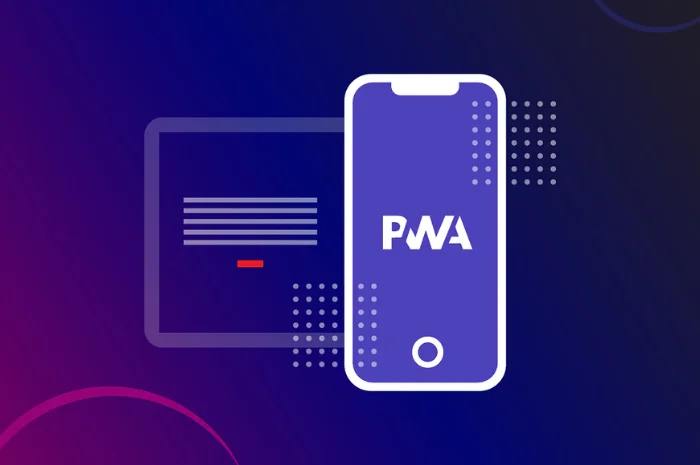Progressive web applications or PWA are web apps that can operate as mobile applications and web pages on any device. These apps are considered one of the best ways to eliminate poor user experience and low conversion rates. PWAs are developed to deliver a native-like user experience with quick loading time, even with a poor internet connection.
JavaScript, CSS, and HTML are some of the primarily used languages for developing PWAs. They act like a standard web page; hence users can access them easily from any web browser. Compared to native mobile apps, PWAs offer similar functionalities. They can work offline, send push notifications to users, and use user devices’ internal features.
Why Have Progressive Web Apps Gained Popularity Over the Years?
PWA technology is a competitor to native frameworks because users don’t want to spend their time and storage space on app installation. If the website is mobile-friendly, they will continue to use it. Look at some of the reasons why the demand to Hire Dedicated Progressive Web App Developers is on the rise for creating robust PWAs.
Easy and Cost-Efficient Development
It is simple and economical to develop PWAs. This allows the same build for multiple platforms and operating systems. Developers only need one code base to create progressive web apps. This reduces both the time and cost of developing PWAs. PWAs can be a good option for start-ups and small businesses.
Native app development, on the other hand, is a time-consuming and complicated process. For example, developers must write code on Android and iOS platforms to make an app compatible with multiple browsers.
Instant Load Time
PWAs are built with progressive enhancements as their core principle. They allow apps to load in real time on repeat visits to a page. This technology uses the device-level cache, reducing the information needed to respond to user interactions.
Many modern web technologies allow apps to save data in the device’s cache and deliver it directly to the users’ devices.
PWAs allow users to make multiple visits to a single page. They display cached content, similar to Native Apps, and then load the rest of their content gradually.
Home-Screen Save
Progressive Web Apps are superior to apps and websites because they allow potential users to add your PWA directly to their Home Screen from their browser. As a result, it makes it much easier to deploy them.
PWA eliminates the need to bookmark a webpage and helps your users avoid searching through Play & App Stores to find the application they are looking for.
Your user won’t need a browser once the PWA has been added. It is always available on the user’s Home Screen so they can access it anytime.
Great Performance
With the help of service workers running in the background, PWAs offer a quick loading time. These scripts are run independently from the web page and pre-fetch all data necessary to ensure seamless navigation. The scripts don’t run on the page and therefore do not slow down page loading.
App navigation is almost instantaneous after the data has been cached. The app can be added to the home screen by users, and it will instantly launch without requiring any additional resources.
No Updating Problems
PWAs offer unique functionality that allows them to update automatically without notifying users or bothering them with permission requests. These apps automatically update themselves when users visit them. This eliminates the need to download and install multiple changes. These apps provide a refreshed look without any human involvement.
Some progressive app producers send push notifications to users to notify them of the new version. However, producers retain complete control over the information and content that users can access.
Conversion Rates
Native apps require developers first to download and install them. Before downloading any app, users must first read reviews and ratings. If your app is not well-received and has few reviews or ratings, users may ignore it.
Users need to follow a few simple steps to access progressive web applications. First, they need to add the PWAs to their home screen. Then, they can quickly access the app to learn more about your products and order them. This increases the conversion rates of your PWA in an unprecedented way.
Top 13 Examples of Impressive Progressive Web Apps Across Various Industries
Now, as you are familiar with some of the most common benefits of progressive web app development, let us look at some of the big brands that have put their trust in Progressive Web App Development Company to create a lite version of their business solutions.
Pinterest is another example of a progressive web app. The company’s first mobile app was launched in 2012 but saw minimal adoption. Only 1% of the company’s mobile users became clients after installing, signing up, or logging into their app.
Pinterest is a powerful search engine that can also be used to target advertising. It has a user base above 440 million as of 2021. Pinterest’s users love the site and will pin anything that is offered. However, only 221 million people use the mobile app. Therefore, Pinterest had to address the poor performance of its native app because it has such a large base.
The platform has seen a 40% increase in visitor time since implementing its PWA in 2019 compared to its mobile site. Another remarkable statistic is that the platform saw a 44% increase in ad revenue and a 60% increase in user engagement.
Flipboard is the most widely read social magazine in the world. It allows users to stay up-to-date on all news and topics they are interested in, all from one place. The platform gathers information and stories from around the globe in a magazine format based on user interests. Flipboard users can follow the stories they like and save them into Flipboard magazines they can read later or share with others.
Flipboard is an excellent example of online news PWA. Flipboard had been a mobile app until the launch of the PWA. After that, it was only presented on mobile devices. Flipboard’s PWA now allows them to offer a similar experience on the web to their native app. It is also available for desktop users.
Lancôme
Lancôme cosmetics is another well-known brand to successfully uses the PWA technology. However, Lancôme discovered a paradox: although mobile users have increased dramatically in recent years, their mobile web conversions are still shallow compared to desktop conversions.
They built a mobile application, which satisfied Lancôme’s loyal customers, who are likely to download it. So they finally decided to create a PWA. Here’s what they got: a 15% decrease in bounce rates, 50% more mobile sessions, and a 17% increase in conversion rates.
Lancôme decided to update its site only occasionally and instead turned to modern web technologies, such as PWA, to create an app-like experience. In addition, service workers were used to providing reliable performance on unstable networks and push notifications for re-engagement.
The best-in-class PWA achieved a score of 94/100 in Lighthouse, an automated tool to improve web page quality.
Starbucks
Starbucks is another example of a PWA that launched its mobile ordering app in 2015. However, it was unsuitable for rural communities with slower internet connections.
It wanted to add ordering functionality to its main website. But they discovered that most customers don’t have stable internet connections.
Starbucks wanted customers to be able to browse their menus online and add items to their shopping carts even when they were offline. It knew from the beginning that a PWA was the only way to go. For their ordering scheme, they created a PWA to ensure that both urban and rural markets could be served.
It’s extremely user-friendly, eye-catching, and easy to use. It feels and looks like a native app, but it is small, fast, responsive, and highly responsive.
It is also available offline, so Starbucks has been able to attract customers without consistent internet access or those unable to use the internet during their workdays.
Tinder
Tinder is one of the most popular progressive web apps.
The dating app has over 60 million monthly users. So they chose a PWA (so-called Tinder Online) to improve user engagement.
Tinder is a tremendous app (48 Mb on Android), so not everyone can install it all at once. These users could try Tinder Online without committing fully to the app. The PWA replicated the native experience but didn’t force users to download the app from the App Store.
They used proven optimization techniques like code-splitting, lazy loading, and service workers to pre-cache all route-level bundles, making the site super-fast.
Debenhams
Debenham, a PWA company, stands out among the many. It helps customers make better fashion purchasing decisions. This well-known UK company discovered that while its old website had increased mobile traffic, its mobile conversion rate hadn’t grown. So they decided that it was time to transform their digital strategy or risk losing their overall digital growth. The brand desired a seamless customer experience on mobile devices.
Debenhams’ team discovered the solution in PWA. They were able to convert their old website into a PWA. By eliminating some severe factors, such as slow websites, a difficult-to-navigate layout, and a complicated checkout procedure, the company could enhance the user experience for their services. As a result, Debenhams reported a 40% increase in mobile sales and a 20% rise in conversions.
Twitter uses PWA technology to power its Twitter Lite platform. In April 2017, this was the default mobile web experience for all users logging onto Twitter. That’s approximately 100 million people per day! So what are the benefits of Twitter Lite over traditional apps? It takes up less storage than the Android version and 3% less space. It also offers big data usage savings. Twitter has credited this with a 75% rise in Twitter’s number of tweets, a 65% increase in pages per session, and a 20% drop in bounce rates.
You can now access Instagram via your mobile browser. You would have had to struggle with the lack of functionality. You could not view your profile or timeline. The PWA is identical to the original app but offers some additional functionality. Although you can upload photos, as usual, it doesn’t provide all the features. Instagram Stories and tags are not available. Instagram still wants you to download the app.
Uber Ride Hailing
Uber’s continued expansion to all corners of the world is no surprise. However, regardless of your knowledge of Uber, you might not have considered the technology that made it so famous. This includes progressive web apps.
Uber was one of the first commercial users of PWA. It launched affectionately to offer users an experience similar to native apps but without straining low-end mobile devices’ performance. PWA can also be used on smartphones and tablets that Uber’s native application does not support. The intention is to ensure that everyone in the Uber global market has the hardware capability to use the innovative service.
Preact was used to build the m.uber app and Webpack to bundle modules. It is extremely small and requires only 50kB of storage space. Moreover, it loads in less than three seconds from the user’s home screen, even on 2G networks.
Telegram PWA
Telegram, a cloud-based messaging platform that is rapidly expanding, is another example of a progressive web application. It is one of the most recent PWAs on the market and doesn’t seem to be slowing down. Telegram, as a PWA app, can adapt to new developments. Telegram’s privacy and encryption features are its main distinction. In addition, the telegram must have a quick response system. This is especially important in an increasingly strict global regulatory environment.
Telegram has over 100 million users. Telegram’s web app is an excellent option for mobile users as it offers a simple and quick experience.
Spotify
Is Spotify a PWA?
Spotify defied Apple’s wishes and quickly developed its iOS progressive web app. Apple wanted to impose a 30% Commission on the App Store in 2017, but Spotify opposed this.
Spotify can now bypass third-party commissions and grow its subscriber base with the new progressive web app for iOS.
Spotify has done an excellent job replicating the native mobile app experience on the desktop and in the PWA. Listeners can also listen to music offline, which is highly convenient.
With a modified UI, the PWA works faster than native apps. For example, Spotify users are prompted to add Spotify PWA to their home screens to improve accessibility.
The Washington Post
The Post is one of America’s most respected publishers. They are determined to bring breaking news to their base of 61 million unique visitors by April 2022. They use a PWA to improve retention, as 83.2% of readers are on mobile devices. The medium’s progressive website app uses the AMP framework to load pages in seconds. In addition, the article’s related links are loaded in the background to encourage further reading when a user opens it.
Flipkart
The PWA of Flipkart, India’s largest e-commerce site, is another impressive example. The Flipkart Lite PWA plays a significant role in boosting conversions (70% rise), re-engaging customers, and stimulating time on site.
It’s also worth noting that most Indian mobile users access the site via 2G networks. Therefore, PWA’s fast-loading page feature, as well as offline functionality, are valuable.
The Flipkart survey shows that more than half of their visitors come from this technology. Moreover, their PWA has a much higher engagement rate than other sources (mobile app and native app).
The Key Takeaway
Using our examples of Progressive Web Apps, you can see the potential and powerful capabilities offered by Progressive Web App development to businesses of all kinds. This technology has been used in various industries, including media, entertainment, and travel.
These are the top PWA examples that we recommend. In addition, PWA solutions offer several benefits to their owners. For example, progressive web applications can help businesses increase conversions and customer engagement.
PWAs are great for forward-thinking brands because they provide consistent UX and speed improvements. A PWA is a better choice than a limited native app for brands that want to offer a mobile-first shopping experience. PWAs have the rich, engaging experience of native apps but without losing the reach and accessibility of a website.







